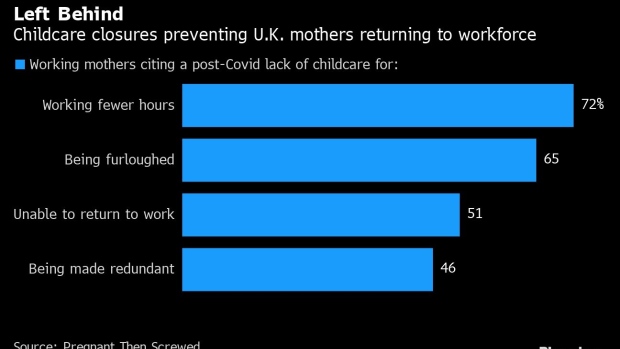Aug 14, 2020
U.K.’s Return to Work Risks Being Stumped by Childcare Closures
, Bloomberg News

(Bloomberg) -- The U.K. government’s plan to get people back to work to fuel the economic recovery is under threat from a rising childcare problem.
Financial difficulties are putting the survival of many childcare facilities at risk, potentially forcing parents to drop out of the labor force to stay at home. Not only does that hit household incomes and consumer spending, it could also undo years of progress in getting more women into work -- with long-term consequences for growth.
A survey last month by childcare.co.uk showed that a third of centers believe they may close permanently -- twice as many as in a similar poll in April -- with the loss of 560,000 places.
Jo Verrill, the managing director of Ceeda, an independent childcare research company, says the typically busy summer months when schools close are crucial for operators to replenish their coffers.
Not this year though -- with parents’ incomes under pressure and unemployment rising, those that are open are at half capacity. U.K. childcare costs for parents are among the highest in the world.
“The true measure is going to be when furlough support ends, to see whether occupancy bounces back early enough for providers to weather the storm,” Verrill said.
Mothers are likely to be worse affected than fathers. Women have already been worse hit than men by the pandemic because they’re more heavily employed in hospitality, leisure and tourism which have been crushed by the crisis.
The Institute for Fiscal Studies found that mothers are more likely to have quit or lost their job during lockdown. Pay differentials are widening, according to reports by poverty charity Turn2us and the Women’s Budget Group, which scrutinizes the gender impact of public policy.
A record 72.4% of women were employed at the end of last year in the U.K., and a reversal of that trend has implications deeper than equality goals. It would be one example of what Bank of England Governor Andrew Bailey calls “scarring” that will slow the recovery.
International Monetary Fund research last year showed that higher female employment boosts economic growth and productivity by bringing different skills and ideas to the workplace.
Prime Minister Boris Johnson’s government is pushing on with plans to wind down furlough programs in the autumn. Yet half of employed women don’t have the childcare provision they would need to go back, according to campaign group Pregnant Then Screwed.
Buying Space
The government does provide subsidies, and has given extra relief during the crisis. A spokesperson for the Department for Education said it has been ‘block-buying’ childcare places for the rest of this year, regardless of attendance levels.
Yet local authorities have also been told that they should only fund closed childcare facilities in the autumn if they are shut for public health reasons.
Economist Jerome De Henau at the Women’s Budget Group says the government should be spending 55 billion pounds ($72 billion) a year to make care widely available for all children.
Instead it’s allocated about a tenth of that, and focused its efforts on very young children.
De Henau says that could undermine Johnson’s plans for an economic revival led by infrastructure construction, which pre-date the virus but have gained added urgency now.
“They’re missing the point if they want to generate good employment and permanent employment in large numbers,” he said. “Any recovery plan that is about creating jobs will have to deal with this childcare question.”
©2020 Bloomberg L.P.